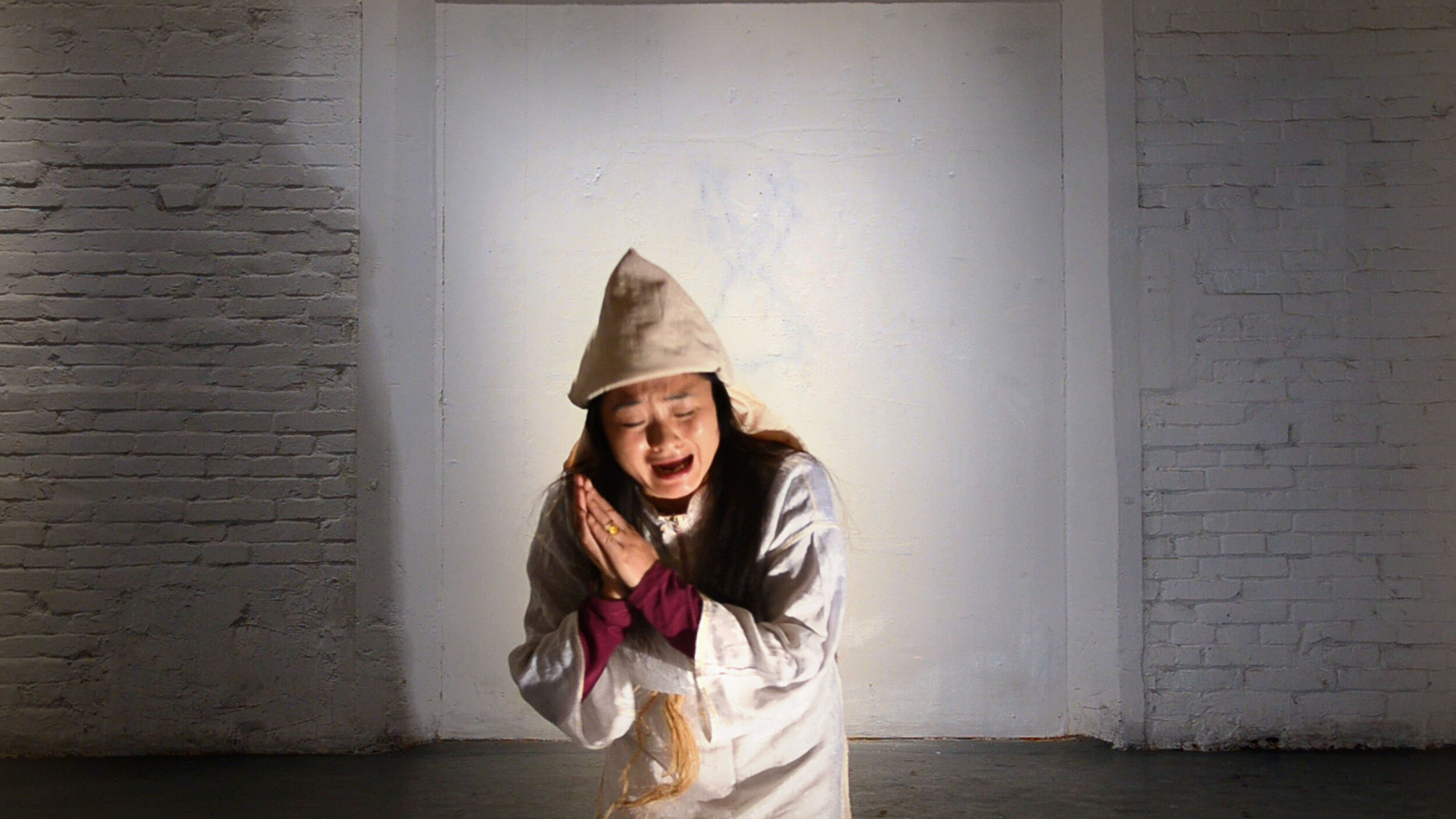Yoke 2012
Overview
I headed to China for a residency at Organhaus in Chongqing. I was intrigued by News reports suggest that families are hiring professional funeral crying services to cry at their loved ones funerals. The wailers are performers, paid to cry for the deceased through anguished songs. By hiring professional mourners, the idea is, is that the criers help conjure up emotional intensity, and the louder one’s funeral is, the more the deceased was loved. It is an ancient custom, but during Mao’s Cultural Revolution wailing was banished, however now it is making a comeback, mostly, it seems, by the more wealthy Chinese. Over the residency Organhaus helped me make contact with the professional criers, and I paid them to cry for me in the studio. I filmed 8 criers over the residency. Dressed in white, they start off with a slow speech and the mourners dramatically fall to their knees, which leads onto a slow crawl forward. With arms wailing, and tears gathering, they sing and moan with an overwhelming intensity. They slowly make there way forward on their knees, and after much dramatic movement – they throw themselves on the ground. After filming this project, I was motivated to see how and why other countries employ professional mourners. In 2013, I searched Sardinia (they seem to have disappeared into history) and Israel (in the Hassidic community they are paid to pray not mourn), which lead me to the professional criers in Rajasthan India. Professional mourning is a Hindu custom, built around the rituals of the Raj. In India, the raj are seen as too godly to emote, so the mourners (called Rudaali’s are brought into cry for them. It was a difficult shoot, as they thought that not crying for the raj, and just crying for me, I could bring bad luck to the raj. I ended up shooting three women from the Rudaali caste, perched on a sacred rock jutting up into the sky, overlooking Jodphur. The women, with veiled faces and colourful saris, slowly cried, rocking themselves back and forth. This was much more gentle and much more colourful than the Chinese mourners.










Yoke, Science Gallery, Trinity College, Dublin
TRAUMA investigates biological, psychological, societal, and cultural traumas in our contemporary, connected world — from the emotional, neurological and mental aspects of trauma to the brutish, the blunt-force, the fractured and the stitched. Exploring our collective resilience in the face of trauma, exhibits consider our ability to heal and the importance of communication and human connections to that process. TRAUMA runs 20.11.15 – 21.02.16 at Science Gallery at Trinity College
Yoke, Science Gallery, Trinity College, Dublin
In 2011 I headed to China for a residency at Organhaus in Chongqing. I was intrigued by News reports suggest that families are hiring professional funeral crying services to cry at their loved ones funerals.
The wailers are performers, paid to cry for the deceased through anguished songs. By hiring professional mourners, the idea is, is that the criers help conjure up emotional intensity, and the louder one’s funeral is, the more the deceased was loved. It is an ancient custom, but during Mao’s Cultural Revolution wailing was banished, however now it is making a comeback, mostly, it seems, by the more wealthy Chinese.
Over the residency Organhaus helped me make contact with the professional criers, and I paid them to cry for me in the studio. I filmed 8 criers over the residency. Dressed in white, they start off with a slow speech and the mourners dramatically fall to their knees, which leads onto a slow crawl forward. With arms wailing, and tears gathering, they sing and moan with an overwhelming intensity. They slowly make there way forward on their knees, and after much dramatic movement – they throw themselves on the ground. After filming this project, I was motivated to see how and why other countries employ professional mourners.
In 2013, I searched Sardinia (they seem to have disappeared into history) and Israel (in the Hassidic community they are paid to pray not mourn), which lead me to the There are many different cultural reasons for using a professional mourner. In China, it is an ancient custom, but during Mao’s Cultural Revolution wailing was banished. However now it is making a comeback, mostly, it seems, by the more wealthy Chinese, who want a loud and hysterical funeral. In India, the Raj express inwardly not outwardly, so the mourners are their conduits for showing grief. But one of the underlying ideas of the professional mourner is the idea of emotional contagion – when we see another emoting, we will feel some of that emotion, so we recognize our own sadness. I imagine the audience will be left in a strange space of feeling grief, while scrutinizing the authenticity of that grief.
After filming this project, I lost my own baby too young, and felt devastated, both by the loss and societies response to the loss. I searched the world for other funeral mourners hoping they might cry for the baby that I never met. We travelled through Sardina (lost to the past), Israel (paid to pray, not mourn). I ended up in Rajasthan India, where professional mourning is a Hindu custom, built around the rituals of the Raj. The Raj express their emotion inwardly not outwardly, so the mourners are their conduits for showing grief. To the people, The Raj are seen as too godly to emote, so the mourners have a role to cry for them.. I told the women my story, and filmed their response. The women, dressed in colourful saris and veils covering their faces, gently weep. A much quieter representation of grief as compared to China.
The Team:
Art & Direction : Tina Gonsalves
Exhibition
Organhaus, China, 2011
Trauma, Science Gallery, Trinity College, Dublin
Funding
Asialink residency CHINA
